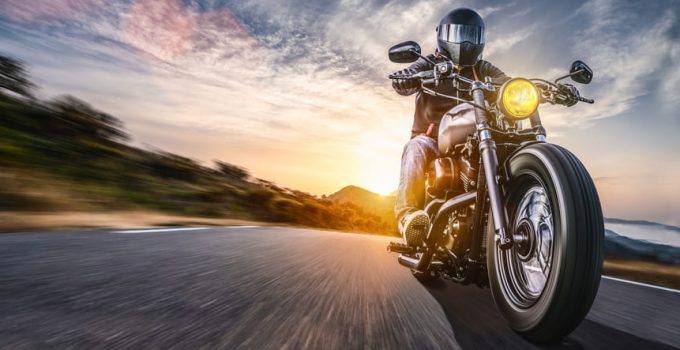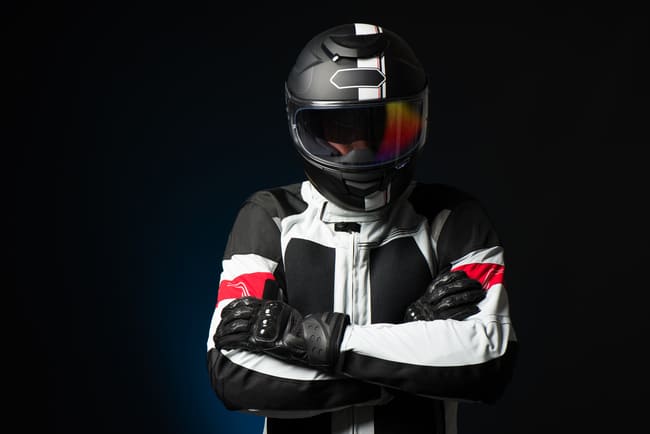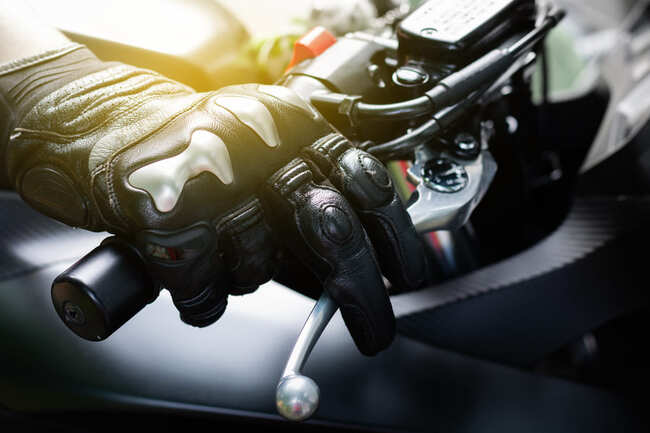
The reasons for a motorcycle driver's license and the associated learning of a new hobby are obvious. Motorcycling is pure adrenaline, gives you a feeling of absolute freedom and is just plain fun. Once you get to know this feeling and the community among bikers, you won't want to do without it anymore. But this hobby can also quickly become very dangerous, especially as a beginner. That's why we'd like to give you a few tips for the right protective equipment and explain what you should definitely pay attention to when riding a motorbike and when buying your first motorcycle to make it as easy and safe as possible for you to start your new hobby.
Contents
What motorcycle equipment do I need?

Before you even get on a motorcycle, you should get suitable protective clothing. This protects you from serious injury in the event of a fall. Good protective gear includes:
- Motorcycle helmet: A flip-up or full-face helmet is recommended for beginners, as they provide the best protection. When choosing, you should make sure that it is ECE or DOT certified and fits correctly. It must be neither too tight nor too wide. You can test this by putting your fingers between your head and the helmet. If that works fine, you should look for a smaller helmet.
- Motorcycle jacket: This not only protects you from serious injuries, but also from the cold and wet. Make sure their protectors are CE certified. In addition, they must be in exactly the right places. This means that the jacket must allow you enough freedom of movement, but it must not be too big.
- Motorcycle pants: These should be made of the same material as your motorcycle jacket.
- Motorcycle boots: These should definitely have toe caps made of metal and fit properly to protect your feet optimally.
- Motorcycle gloves: Make sure your gloves fit well, don't wrinkle and can be attached to the wrist with Velcro.
How do you ride a motorcycle?

It is very important that you are healthy and physically fit when you set off on your bike. Because motorcycling requires your undivided attention. The following tips should help you as a beginner to get started with your hobby.
- Adjust the seat height: You need to be able to plant both soles of your feet while keeping your legs straight.
- Seat position: Sit upright and relaxed on your machine and make sure you can see everything clearly can. Also make sure that you can easily reach all controls. When holding the handlebars, you should bend your elbows slightly. You should also familiarize yourself with the weight of your bike before your first ride.
- Get to know the controls: In general, you can remember that you use the controls on the left for shifting and those on the right for braking and accelerating. The lever on the left side of the handlebars is the clutch that you use to shift gears. You can shift gears with your left foot. The order is usually 1st gear, neutral, 2nd gear, 3rd gear, etc. To accelerate you turn the right hand grip and to brake you should preferably open the lever on the right side of the handlebars (front brake) and the foot pedal on the right side (rear wheel brake) at the same time to distribute the braking force evenly to both wheels.
- Check the brakes and lights: This is important to avoid accidents and other road users *to be seen better inside.
- Driving safety training: Even if it is mandatory in The United Kingdom to get a driver's license for the respective motorcycle class, it is advisable to also complete a driver safety training course. You can repeat this later, especially if you rarely use your motorcycle.
- Start the engine: To do this, you have to pull the clutch and set the emergency stop switch (red button on the right side of the handlebars) to “on”. On older models, you start your motorcycle using the kick start lever behind the right footrest. After you turn the ignition key to “On,” you must shift into neutral. This is indicated by a flashing “N” (neutral). Now you can press the “Start” button (circular arrow with a lightning bolt in the middle) on the right side under the emergency button. Then let your engine warm up for about 45 seconds to ensure it runs smoothly.
- Drive off: Slowly release the clutch and operate the gear shifter with your left foot to shift into first gear. The display on the handlebars shows you the currently selected gear. As soon as the motorcycle moves forward, you can accelerate a little and put your feet on the two footrests.
- Shifting: While riding, you should make sure that you ease off a bit when changing gears to prevent your bike from jumping forward. After shifting, slowly release the clutch to avoid stalling your engine.
- Braking and stopping: To do this, apply the rear and front brakes simultaneously while the clutch is pulled in. Support your bike with your left foot when you stop. Once you are standing, you can also take your right foot off the footrest and put it on the ground.
- Ride with foresight and at a steady pace: This is very important, especially at the beginning, in order to avoid hard braking maneuvers as far as possible, as these often overwhelm you as a beginner. Get a feel for your motorcycle before you start getting the most out of your engine.
- Ride defensively: You should only attempt overtaking maneuvers when you feel absolutely safe. Also, always expect other road users to make mistakes and always be ready to brake.
- Corners: As a beginner, you should slow down before cornering your motorcycle to avoid leaning too much.
- Gain riding experience: This is best done on group tours with experienced bikers, from whose driving style you can learn a lot. However, make sure to take regular breaks and to be on the road for a maximum of 2 to 3 hours at the beginning. After that you can slowly improve.
Which motorcycle is the best for beginners?
There is no general answer to this question, as it depends on various factors which bike is the right one for you as a newcomer. This primarily includes your driving license class, but also your personal preferences and needs, your size and your strength. In general, bikes with a low center of gravity are recommended, as these mistakes are more forgiving and still remain stable.
At the age of 16 you can already get an A1 driver's license, which allows you to drive light motorcycles with 125 ccm displacement, 11 kW power and an unladen weight of approx. 100 kg. With an A2 driver's license, which you can get at the age of 18, you can drive motorcycles with an unladen weight of around 175 kg and 35 kW power. This power limitation also has the advantage that you are not even tempted to drive too fast or aggressively. Because newcomers tend to overestimate their abilities.
Next, you have to think about where and for which applications you want to use your motorcycle most often. Whether you want to use it mainly for everyday use, longer tours or sporty off-road rides, there are suitable entry-level motorcycles for all needs. Here you can choose between scooter, naked bike, tourer, super sports bike, enduro, supermoto and cruiser.
A lightweight beginner's motorcycle is particularly suitable for young people and women. However, this is also recommended overall, as you will feel every kilogram at first, and you should also be able to catch a tipping motorcycle to avoid damage and injuries. It is therefore particularly difficult for tall people to find a suitable beginner's motorcycle, since the seat height is often too low on the lighter ones. Therefore, before you buy, you should definitely take a test ride to see if the seat height is optimal for you and if you can handle the weight of the machine.
Conclusion
Once you have decided to get your motorcycle license and you have it in your pocket, the first thing to do is to gain driving experience. But don't overestimate yourself, drive as defensively as possible, always be ready to brake and don't let yourself be rushed. When you buy your first bike, you should definitely take it for a test ride. If you don't feel comfortable with it, then it's not the right one for you, no matter how good it looks.
